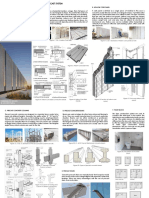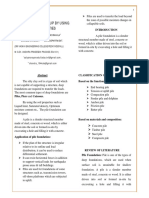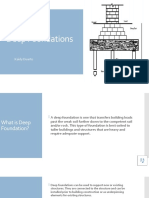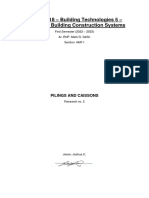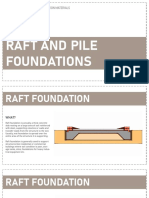Sobremonte, Regine I. (MT-RSW-02)
Sobremonte, Regine I. (MT-RSW-02)
Uploaded by
Regine Ignacio SobremonteCopyright:
Available Formats
Sobremonte, Regine I. (MT-RSW-02)
Sobremonte, Regine I. (MT-RSW-02)
Uploaded by
Regine Ignacio SobremonteOriginal Title
Copyright
Available Formats
Share this document
Did you find this document useful?
Is this content inappropriate?
Copyright:
Available Formats
Sobremonte, Regine I. (MT-RSW-02)
Sobremonte, Regine I. (MT-RSW-02)
Uploaded by
Regine Ignacio SobremonteCopyright:
Available Formats
SOBREMONTE, REGINE I.
BS ARCHITECTURE-4 TYPES OF FOUNDATION
Shallow foundation Deep foundation
It will be on the surface of It will drive to lower soil
the ground level. layers such as pile and pier
Fig.1. Comparison of pressure distribution and soil disturbance
PILE FOUNDATION beneath spread and piled foundations (a) Spread foundation (b)
Single pile
Pile foundations are deep foundations. They are formed by long, 2. FRICTION PILE
slender, columnar elements typically made from steel or reinforced
concrete, or sometimes timber. A foundation is described as piled when its This type of pile utilizes
depth is more than three times breadth (ref. Atkinson, 2007). the frictional resistance
force between
Although the use of pile foundation cost more than shallow 5 foundation, it the pile surface and
is combination of skin friction essential to be employed for some conditions. adjacent soil to transfer
Such Conditions Are Enumerated Below: the superstructure load.
Depending on the subsoil
strata condition,
resistance force due
to friction can develop in
a definite pile length of
on the full length.
Fig.9. Friction pile
Fig.2. The upper soil Fig.3. Bedrock is not Fig.4. Subjected to
layer is too weak encountered at a horizontal forces
reasonable 3. COMPACTION PILE
Are one of the potential methods for improving ground
stability, preventing liquefaction, reducing settlement and
similar applications. This method involves driving a
hollow steel pipe into the ground. The bottom is closed
with a collapsible plate down to the required depth and
then pipe is filled with sand. The pipe is withdrawn while the
air pressure is directed against the sand inside it.
Fig.5. Expansive & Fig.6. Foundations Fig.7. Bridge
collapsible soils below the water abutments and piers
extend to a great table are subjected are to avoid the
depth below the to uplifting forces possible loss of
ground surface bearing capacity
CLASSIFICATION OF PILE BASED ON FUNCTION
1. END BEARING PILE
Which is also known as point-
bearing piles, are used to transfer
superstructure load through low
bearing capacity soil to a strong.
End-bearing piles develop most of
their load-bearing capacity at the toe
of the pile, bearing on a
Fig.10. Compaction pile
hard layer of rock or very
dense soil and gravel.
The pile transmits the load through 4. TENSION PILE
soft, compressible strata directly onto
Also known as uplift piles or anchor piles, are a type
firm strata. This type
of pile foundation that is used to resist uplift forces that
of pile therefore acts in the same way
might otherwise cause it to be extracted from the ground.
as a column.
Uplift forces can develop as a result of hydrostatic
pressure, seismic activity or overturning moments.
Fig.8. End Bearing Piles
CLASSIFICATION OF PILE BASED ON MATERIAL
1. TIMBE PILES
Is an ideal material for piling. It has a high strength to weight
ratio, it is easy to handle, it is readily cut to length and trimmed
after driving.
Fig.11. Tension pile
5. ANCHOR PILE
Are piles used to resist uplift or inclined tensile? forces in the
surrounding ground. They are used as: (1)
Reaction piles for pile testing. (2) Piles to resist uplift forces from
flotation.
Fig.16. Timber Piles
PREPARATION OF TIMBER PILE IN THE SITE:
Timber piles To avoid To avoid the
cannot damage at damage to
withstand the bottom the top of the
hard driving of timber piles, a metal
stress, piles, steel band or a
Fig.12. Anchor pile
therefore shoes may cap may be
6. FENDER PILE be used used
These are used to protect water front structures against impact
from ships or other floating objects.
Fig.17. Protecting timber piles from decay (a) By precast concrete upper
Fig.13. Fender pile
section above water level (b) By extending pile cap below water level.
7. BETTER PILE
They are used for resist large horizontal forces or inclined
forces.
Fig.18. Protecting timber piles from splitting during driving (a) Protecting head
by mild steel hoop (b) Protecting toe by cast steel point.
Fig.14. Better pile
8. SHEET PILE
They are used as bulk heads or as impervious cutoff to reduce
seepage and uplift under hydraulic structures.
Fig.19. Driven Timber piles in
the site
Fig.15. Sheet pile on site
ADVANTAGES OF TIMBER PILE ADVANTAGES OF PRECAST CONCRETE PILE
▪ They can easily be extracted ▪ Can be subjected to hard driving.
▪ They are economical in cost. ▪ Corrosion resistant.
▪ They can stay undamaged indefinitely if they are ▪ Can be easily combined with a concrete superstructure.
surrounded by saturated soil.
DISADVANTAGES OF PRECAST CONCRETE PILE
DISADVANTAGES OF TIMBER PILES ▪ Difficult to achieve proper cutoff.
▪ Difficult to transport.
▪ Timber pile cannot withstand hard driving stress.
▪ The pile capacity is generally limited.
▪ Top of timber easy to damage during the driving ▪ CAST-IN-PLACE CONCRETE PILES
operation.
Piles are built by making a hole in the ground and then filling
▪ Subject to attack by various organisms and insects.
it with concrete. These piles may be divided to two: (a) cased (b)
uncased. Both types may have a pedestal at the bottom.
▪ CAST-IN-PLACE CONCRETE PILES
2. CONCRETE PILES Piles are built by making a hole in the ground and then filling it with
concrete. These piles may be divided to two: (a) cased (b)
uncased. Both types may have a pedestal at the bottom
Concrete piles are precast, that is, made at ground level,
and then driven into the ground by hammering.
▪ PRECAST CONCRETE PILE
They have their principal use in marine and river structures,
i.e. in situations where the use of driven and cast-in-place piles
Fig.23. top view of a Fig.24. Cast in place concrete pile
is impracticable or uneconomical. cast-in-place pile
▪ BULB PILES
They are special forms of cast-in-place concrete piles. It
forms a large base (bulb) during the driving process increases their
effectiveness in serving as an end bearing pile.
Fig.20. Precast Concrete Piles
Fig.25. Bulb Pile
▪ JOINTED PRECAST CONCRETE PILES ▪ SHELL TYPES CAST-IN-PLACE PILES
Casting on additional lengths to accommodate variations Consist of a permanent light gauge steel tube in diameters from
in the depth to a hard bearing stratum will be evident. These 150 to 500 mm with wall thickness up to 6 mm and are internally
drawbacks can be overcome by employing jointed piles. bottom driven by drop hammer. On reaching the bearing layer
the hammer is removed, any reinforcement inserted, and a high
slump concrete placed to produce the pile.
Fig.21. Typical locking pin joint Fig.22. Unseen breakage of
for precast concrete pile. precast concrete piles with
welded butt joints. Fig.26. The Taper Tube pile
▪ ROTARY DISPLACEMENT AUGER PILES ▪ SHOES FOR STEEL PILES
The soil is displaced and compacted as the auger head is Shoes or other strengthening devices at the toe are needed for
rotated into the ground to form the stable pile shaft, with little tubular piles driven with open ends in easy to moderately easy
soil being removed from the hole. driving conditions. Where open-ended piles have to be driven
through moderately resistant layers to obtain deeper penetrations,
or where they have to be driven into weak rock, the toes should
be strengthened by welding-on a steel ring.
Fig.30. Strengthening shoe of Fig.31. Buckling and tearing of
tubular steel pile by cruciform welded-on external stiffening ring
plates to tubular steel pile driven on to
sloping rock surface
Fig.27. Bulb Pile
4. COMPOSITE PILES
ADVANTAGES OF CAST-IN-PLACE CONCRETE PILES Combinations of bored piles with driven piles can be used to
overcome problems resulting from particular site or ground
▪ Relatively low cost.
conditions such as the problem of timber piles above ground-
▪ Allow for inspection before pouring concrete.
water level. In this pile advantage is taken of durability of
▪ Easy of length variation.
concrete piles and the cheapest of timber pile.
▪ Minimal ground vibrations during installation.
DISADVANTAGES OF CAST-INPLACE CONCRETE PILES
▪ The uncertainty of the shape and condition of the
constructed pile.
▪ The cast components may be damaged during driving.
▪ Difficult to splice after concreting.
▪ Steel casings (temporary or permanently) and
reinforcing cages may also be required.
▪ Cast-in-place concrete pile lengths are limited by the
drilling equipment used.
3. STEEL PILES
Are either pipe pile or rolled section steel H- section piles.
Pipe pile can be driven into the ground with their ends open or Fig.32. Different stages in construction of composite piles
close. Wide-flange and I-section steel beams can also be used
as piles. H-section piles are usually preferred because their web
and flange thickness are equal. 4. SAND PILES
These piles are formed by making hole in ground and fill with
the sand and well rammed. The sand to be used should be moist
at time of placing. Bore hole diameter usually 30 cm. length of
sand pile is kept about 12 times its diameter. The top of sand pile
is filled with concrete. Sand pile are placed at 2 to 3 m spacing.
Load test should be carried out determining the bearing
capacity of sand pile. Properly compacted sand pile can carry
load up to 100 tone/m2 or more.
Fig.28. Shape of Steel Piles
Fig.29. Shape of Steel Piles
Fig.33. Shape of Steel Piles
CLASSIFICATION OF PILE BASED ON METHOD OF 4. SCREW PILE
INSTALLATION
Sometimes referred to as screw anchors, screw-piles, helical
1. DRIVEN PILE piles, and helical anchors are a steel screw-in piling and ground
anchoring system used for building deep foundations. Screw
These piles are driven into ground by applying blow with a
piles are manufactured using varying sizes of tubular hollow
heavy hammer. Timber, steel and precast concrete pile are
sections for the pile or anchors shaft.
installed by driving.
Fig.39. Screw pile
5. JACKED PILE
These piles are jacked into the ground by applying a
Fig.34. Placement of Fig.35. Installation of Fig.36. Repetition of
Pile
downward force by a hydraulic jack.
Pile Process
2. DRIVEN AND CAST-IN-SITU PILE
These piles are formed by driving a casing with a closed
bottom end into the soil. The casing is later filled with concrete.
• The casing may or may not be withdrawn.
Fig.40. Jacked pile
Fig.37. Driven and Cast-In-Situ Pile on site
6. UNDER REAMED PILE
An under reamed pile is bored cast-in-situ concrete pile
having one or more bulbs or under reamed in its lower level.
3. BORE AND CAST-IN-SITU PILE
These piles are formed by excavating a hole into the ground
and then filling it with concrete.
Fig.41. Single bulb cast-in-situ Fig.42. Multi bulb pile
Fig.38. Bore and Cast-In-Situ Pile on site pile
You might also like
- Raft FoundationsDocument26 pagesRaft FoundationsSanjana Bhandiwad100% (3)
- Elements of Precast SystemDocument9 pagesElements of Precast SystemRegine Ignacio SobremonteNo ratings yet
- Detailed Lesson Plan in Grade 11 Tle Electricity @19Document6 pagesDetailed Lesson Plan in Grade 11 Tle Electricity @19ramel gedor100% (1)
- Presentation On FoundationsDocument14 pagesPresentation On FoundationsShiwangi Nagori100% (1)
- gt2? - convertedDocument7 pagesgt2? - convertedyadduuu17No ratings yet
- GT (2)Document6 pagesGT (2)yadduuu17No ratings yet
- Design of A Pile GroupBy UsingSoil PropertiesDocument12 pagesDesign of A Pile GroupBy UsingSoil PropertiesYogie Fian ZahriNo ratings yet
- Foundation ReportDocument22 pagesFoundation ReportKonika VermaNo ratings yet
- Assignment #1 - MamornoDocument19 pagesAssignment #1 - MamornoYna Hadassa A. MamornoNo ratings yet
- Lecture 09 - Design of Pile Foundation - Part 01 02Document50 pagesLecture 09 - Design of Pile Foundation - Part 01 0221LE0079 Pasindu PrabashwaraNo ratings yet
- Trouble Areas Types Reason For Use: Soil Type FoundationDocument6 pagesTrouble Areas Types Reason For Use: Soil Type FoundationP S HARSHITANo ratings yet
- Factors Affecting Bearing CapacityDocument4 pagesFactors Affecting Bearing Capacitybasiljoy787No ratings yet
- Introduction To Pile Foundations: Pile Foundation Design: A Student GuideDocument12 pagesIntroduction To Pile Foundations: Pile Foundation Design: A Student GuideDeepak SaxenaNo ratings yet
- CHAPTER 2 - DEEP FOUNDATIONDocument16 pagesCHAPTER 2 - DEEP FOUNDATIONEizz AwesomeNo ratings yet
- Piles DesignDocument12 pagesPiles Designn_sasanNo ratings yet
- 16 - EQRD - Building FoundationDocument24 pages16 - EQRD - Building FoundationKiran MandepudiNo ratings yet
- Fundaciones Con PilotesDocument48 pagesFundaciones Con PilotesReddy M.Ch.No ratings yet
- CHAPTER 2 - SHALLOW FOUNDATIONDocument23 pagesCHAPTER 2 - SHALLOW FOUNDATIONEizz AwesomeNo ratings yet
- Foundation and Retaining Walls Design 1.1Document5 pagesFoundation and Retaining Walls Design 1.1Vinah Mae ButalNo ratings yet
- Pile Foundation: Classification of Pile FoundationsDocument1 pagePile Foundation: Classification of Pile FoundationsPrabhakar SvNo ratings yet
- Bearing CapacityDocument8 pagesBearing CapacityDesalegn TamirNo ratings yet
- Deep Foundations: Kaidy DuarteDocument22 pagesDeep Foundations: Kaidy DuarteCynthia XiuNo ratings yet
- Disaster Resistant BuildingDocument27 pagesDisaster Resistant BuildingTanmoy DattaNo ratings yet
- Topic 3: Foundation: CSE565 Construction Technology Ir DR Eddie LamDocument11 pagesTopic 3: Foundation: CSE565 Construction Technology Ir DR Eddie Lamzhiliang yangNo ratings yet
- BMC Shallow FoundationsDocument6 pagesBMC Shallow Foundationsshenaz AfroseNo ratings yet
- Foundation PilesDocument123 pagesFoundation PilesPravindNo ratings yet
- Pile FoundationDocument12 pagesPile FoundationabdullahiamuwaNo ratings yet
- Sheet Piles Walls: Name TitleDocument4 pagesSheet Piles Walls: Name TitleKristin ArgosinoNo ratings yet
- Adobe Scan 07-May-2024Document5 pagesAdobe Scan 07-May-2024amrendramani345No ratings yet
- Answer Keys BuildingnDesignDocument14 pagesAnswer Keys BuildingnDesignjcNo ratings yet
- Master OneDocument8 pagesMaster OneH.b. DawudNo ratings yet
- Foundation StandardsDocument2 pagesFoundation StandardsMariappan .PNo ratings yet
- Lecture 1Document19 pagesLecture 1Danielle AlbertoNo ratings yet
- chapter 4.1 Foundation & Soil ExplorationDocument77 pageschapter 4.1 Foundation & Soil ExplorationnathanshumisNo ratings yet
- Ge 12Document11 pagesGe 12sharmamayur2023No ratings yet
- NG3S109 Bearing Capacity-JD Yr3Document69 pagesNG3S109 Bearing Capacity-JD Yr3rizwan ghafoorNo ratings yet
- Chap 1 Foundation & BasementsDocument92 pagesChap 1 Foundation & Basementssulavghimire098No ratings yet
- Types Foundations NotesDocument15 pagesTypes Foundations NotesPeter OyugiNo ratings yet
- Foundations 1Document15 pagesFoundations 1nyakwakashaNo ratings yet
- FoundationsDocument15 pagesFoundationstsimbakamNo ratings yet
- Document (1)Document13 pagesDocument (1)Pranesh SaravananNo ratings yet
- 005 Bt3-Foundation System Part 1 by ArtDocument24 pages005 Bt3-Foundation System Part 1 by ArtItzuki FujiwaraNo ratings yet
- Rekayasa Pondasi 1 - 2. Pengenalan Dasar PondasiDocument30 pagesRekayasa Pondasi 1 - 2. Pengenalan Dasar PondasiUmmi khadijah LubisNo ratings yet
- Foundations: Defi Nition of The Term Foundation'Document16 pagesFoundations: Defi Nition of The Term Foundation'Aniculaesi MirceaNo ratings yet
- Chapter 5.1 Foundation (Part 1)Document53 pagesChapter 5.1 Foundation (Part 1)Issack Mattew100% (1)
- Foundation and FootingsDocument13 pagesFoundation and Footingsdariusarwentira2004No ratings yet
- Chapter 6 (p1)Document25 pagesChapter 6 (p1)Jullie Anne SantoyoNo ratings yet
- EXCAVATIONDocument16 pagesEXCAVATIONKashyap GoradiaNo ratings yet
- Tutorial 2Document21 pagesTutorial 2api-339788639No ratings yet
- Application of Deep Foundation: (Yash Prabhat Priadarshi) (17-11-050)Document45 pagesApplication of Deep Foundation: (Yash Prabhat Priadarshi) (17-11-050)Yash PrabhatNo ratings yet
- Introduction To Foundation in EngineeringDocument2 pagesIntroduction To Foundation in EngineeringCHRISTIAN NATHANIEL PALMANo ratings yet
- Introduction To Foundation in EngineeringDocument2 pagesIntroduction To Foundation in EngineeringCHRISTIAN NATHANIEL PALMANo ratings yet
- Types of Piles According To Method of InstallationDocument13 pagesTypes of Piles According To Method of InstallationShara PalosNo ratings yet
- Types of Foundation 1Document11 pagesTypes of Foundation 1Saad SohailNo ratings yet
- Pilings and CaissonsDocument8 pagesPilings and CaissonsJoshua C. JosonNo ratings yet
- Art306 Building and Construction Materials: Assignment IvDocument19 pagesArt306 Building and Construction Materials: Assignment IvAbhishek SoniNo ratings yet
- 149-Article Text-425-1-10-20181120 PDFDocument6 pages149-Article Text-425-1-10-20181120 PDFDavid HongNo ratings yet
- Chapter 3 - Substructure Foundation WorksDocument90 pagesChapter 3 - Substructure Foundation WorksPhillip Mendez100% (2)
- Chapter-3 FoundationDocument53 pagesChapter-3 Foundationkader ArefeNo ratings yet
- Pressure, Resistance, and Stability of Earth American Society of Civil Engineers: Transactions, Paper No. 1174, Volume LXX, December 1910From EverandPressure, Resistance, and Stability of Earth American Society of Civil Engineers: Transactions, Paper No. 1174, Volume LXX, December 1910No ratings yet
- ST Sy FN Otr 01Document1 pageST Sy FN Otr 01Regine Ignacio SobremonteNo ratings yet
- ST Sy FN Quiz 01Document4 pagesST Sy FN Quiz 01Regine Ignacio SobremonteNo ratings yet
- Module 4T BeamsDocument10 pagesModule 4T BeamsRegine Ignacio SobremonteNo ratings yet
- Micro Emission Sun-Moon Mansion, Dezhou China Designed by Huang MingDocument2 pagesMicro Emission Sun-Moon Mansion, Dezhou China Designed by Huang MingRegine Ignacio SobremonteNo ratings yet
- Shear and Diagonal Tension: GeneralDocument10 pagesShear and Diagonal Tension: GeneralRegine Ignacio SobremonteNo ratings yet
- Space Frame and Shell Museum Structure: PerspectiveDocument1 pageSpace Frame and Shell Museum Structure: PerspectiveRegine Ignacio SobremonteNo ratings yet
- Cast in Place and PrecastDocument1 pageCast in Place and PrecastRegine Ignacio SobremonteNo ratings yet
- Advantages:: Types and Forms of Shell StructuresDocument2 pagesAdvantages:: Types and Forms of Shell StructuresRegine Ignacio SobremonteNo ratings yet
- Problem 11Document12 pagesProblem 11Regine Ignacio SobremonteNo ratings yet
- Raised Floor System: SystemsDocument2 pagesRaised Floor System: SystemsRegine Ignacio SobremonteNo ratings yet
- Reinforced Concrete Design-Cua: S s2 S s2 y S SDocument9 pagesReinforced Concrete Design-Cua: S s2 S s2 y S SRegine Ignacio SobremonteNo ratings yet
- Systems: Trunking System Corner Lock SystemDocument2 pagesSystems: Trunking System Corner Lock SystemRegine Ignacio SobremonteNo ratings yet
- Circuit Breakers, Reclosers, Switches, and Fuses: Section 17Document5 pagesCircuit Breakers, Reclosers, Switches, and Fuses: Section 17williamNo ratings yet
- Metal Forming Processes - FullDocument91 pagesMetal Forming Processes - FullmohammadNo ratings yet
- IPC-4554-2005 浸没镀锡印刷电路板规范Document18 pagesIPC-4554-2005 浸没镀锡印刷电路板规范ttNo ratings yet
- Effect of Geometry On Wind Pressures On Low-Rise Hip Roof BuildingsDocument25 pagesEffect of Geometry On Wind Pressures On Low-Rise Hip Roof BuildingsWilliam PolNo ratings yet
- Iii Me Ii Sem Q.bank 2016-17Document32 pagesIii Me Ii Sem Q.bank 2016-17Abhishek SakatNo ratings yet
- Experiment No. 8 Water Jet Impinging On A BladeDocument6 pagesExperiment No. 8 Water Jet Impinging On A BladeJay-ar BensOnNo ratings yet
- Fluid Mechanics: BUOYANCY-The Lifting Force Applied To Submerged ObjectDocument5 pagesFluid Mechanics: BUOYANCY-The Lifting Force Applied To Submerged ObjectYakup TasalıNo ratings yet
- General Physics 1 - QTR2 - LAS - Caraga RegionDocument58 pagesGeneral Physics 1 - QTR2 - LAS - Caraga RegionZylaNo ratings yet
- Chapter III - Electrical Power Generation Using Speed Breaker - Jefferson BeloDocument6 pagesChapter III - Electrical Power Generation Using Speed Breaker - Jefferson BeloJefferson BeloNo ratings yet
- UM 822 014 ATG2 En-GbDocument24 pagesUM 822 014 ATG2 En-Gbtoineoudshoorn14gmail.comNo ratings yet
- Power Lines and TransformersDocument4 pagesPower Lines and TransformersUkash Adan FaditNo ratings yet
- Multi Bypass Tray BY 5010 D517 - EXP - V1.06Document29 pagesMulti Bypass Tray BY 5010 D517 - EXP - V1.06serviciosdaltNo ratings yet
- Heuft Inline BrochureDocument19 pagesHeuft Inline BrochureWandersonNo ratings yet
- Download Complete An Introduction to Statistical Mechanics and Thermodynamics 2nd Edition Robert H. Swendsen PDF for All ChaptersDocument41 pagesDownload Complete An Introduction to Statistical Mechanics and Thermodynamics 2nd Edition Robert H. Swendsen PDF for All Chaptersdartarikwuje100% (2)
- BEE GU Assignment Question BankDocument3 pagesBEE GU Assignment Question BankSajan ChourasiaNo ratings yet
- Hand Lay Up Process For Composite FormationDocument8 pagesHand Lay Up Process For Composite FormationRISHIKA RANYALNo ratings yet
- Pplication OTE: Low Voltage DC Supply Dimmable Ballast For 1 X 36W T8 LampDocument13 pagesPplication OTE: Low Voltage DC Supply Dimmable Ballast For 1 X 36W T8 LampBravo MacNo ratings yet
- Sensors, Actuators and MeasurementDocument3 pagesSensors, Actuators and MeasurementVinayak Dakre100% (1)
- Hvac & R (V - Lab) Expt No. 9Document13 pagesHvac & R (V - Lab) Expt No. 9priyanemade668No ratings yet
- Rotational Motion: M V O ADocument1 pageRotational Motion: M V O APornachandraRaoNo ratings yet
- Characterizing of Cooling Equipment For Closed GreenhousesDocument8 pagesCharacterizing of Cooling Equipment For Closed GreenhousesJaviercm10No ratings yet
- Preparing Your FacilityDocument5 pagesPreparing Your Facilityengeinduol.com.brNo ratings yet
- Characterization of Ductile Iron Through Fractographic StudyDocument60 pagesCharacterization of Ductile Iron Through Fractographic StudyUma KoduriNo ratings yet
- GMAWDocument9 pagesGMAWMathias NsimbeNo ratings yet
- Common Drilling GuidelinesDocument57 pagesCommon Drilling Guidelineshamid.alobaidi1986No ratings yet
- SGP Unit 1Document20 pagesSGP Unit 1radheshyam jatNo ratings yet
- Hydraulic Fire Calculations PDF FreeDocument16 pagesHydraulic Fire Calculations PDF Free8benitez suiteNo ratings yet
- Dokumen - Tips Maestra Infantil n29Document35 pagesDokumen - Tips Maestra Infantil n29Rocii PardoNo ratings yet
- RMH HiraDocument12 pagesRMH HiraShirley SetshediNo ratings yet


